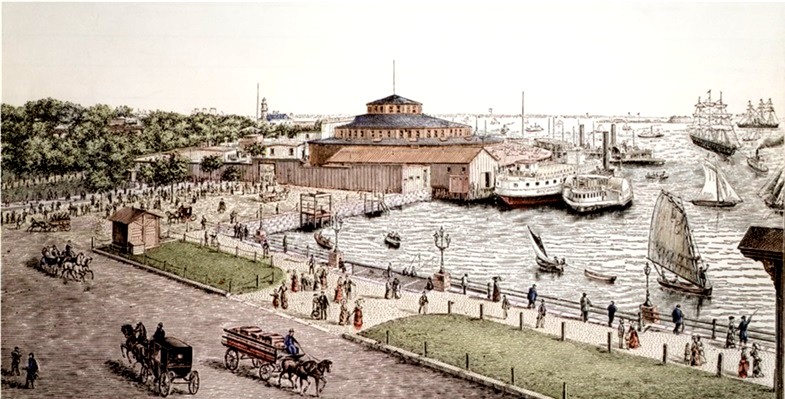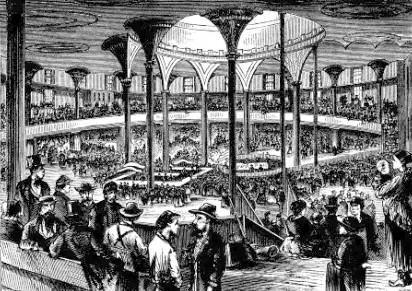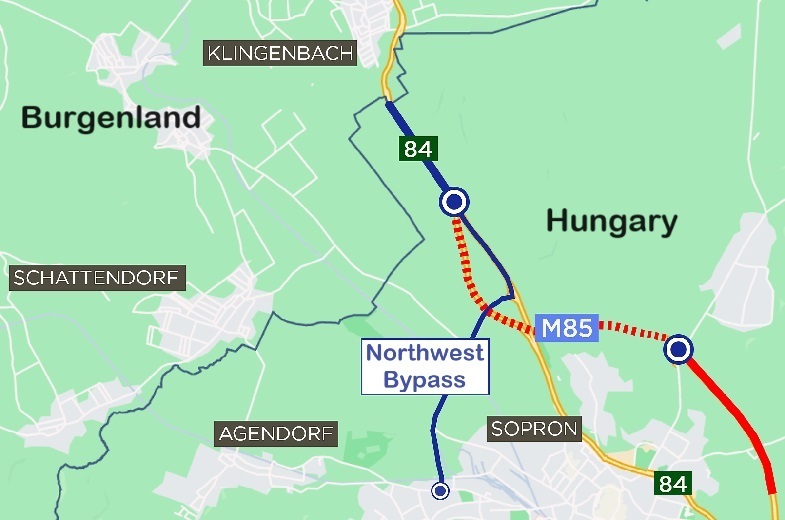|
The
|
THE BURGENLAND BUNCH NEWS - No. 354 May 31, 2024, © 2024 by The Burgenland Bunch All rights reserved. Permission to copy excerpts granted if credit is provided. Editor: Thomas Steichen (email: tj.steichen@comcast.net) BB Home Page: the-burgenland-bunch.org BB Newsletter Archives: BB Newsletters BB Facebook Page: TheBurgenlandBunchOFFICIAL Our 28th year! The BB was founded in 1997 by Gerald Berghold (1930-2008). |
| Current Status Of The BB: * Members: 3229 * Surname Entries: 9378 * Query Entries: 5967 * Staff Members: 14 |
| This newsletter concerns: 1) THE PRESIDENT'S CORNER 2) CASTLE GARDEN 3) HISTORICAL BB NEWSLETTER ARTICLES: - The Carolingian Colonization of Lower Burgenland (by Wilhelm Schmidt) 4) ETHNIC EVENTS 5) BURGENLAND EMIGRANT OBITUARIES (courtesy of Bob Strauch) |
1) THE PRESIDENT'S CORNER (by Tom Steichen)  This
month's random bits and pieces (Article 1) begin with a short bit about a new
FamilySearch feature: A cemeteries search tool. From there, I riff on the "rules"
of sentence construction in English (not directly tied to genealogy/history of Burgenland, but something I
must struggle with [slightly] every time I write the newsletter!). The third bit is about something you likely
only vaguely knew about... but is going through changes now: leasing of land owned by Catholic parishes in
Burgenland. The fourth bit is about the Austrian State Treaty of 1955 that restored Austria as an
independent, sovereign country after its occupation following World War II. The final bit is a revisit to the
Burgenland-area commuter traffic problem... but with a twist. This
month's random bits and pieces (Article 1) begin with a short bit about a new
FamilySearch feature: A cemeteries search tool. From there, I riff on the "rules"
of sentence construction in English (not directly tied to genealogy/history of Burgenland, but something I
must struggle with [slightly] every time I write the newsletter!). The third bit is about something you likely
only vaguely knew about... but is going through changes now: leasing of land owned by Catholic parishes in
Burgenland. The fourth bit is about the Austrian State Treaty of 1955 that restored Austria as an
independent, sovereign country after its occupation following World War II. The final bit is a revisit to the
Burgenland-area commuter traffic problem... but with a twist.Our regular tidbits include the monthly BB Facebook report, book sales (with a little analysis) and a Cartoon of the Month. Unlike most months, this month I provide an extended article, rather than just the bits and pieces of this
article 1. Article 2 is about an emigrant processing facility that gets far less mention than Ellis Island:
Castle Garden was New York's first facility dedicated entirely to immigrants coming to America, operating
from 1855 to 1890. My Burgenland immigrants were part of the first wave of Burgenland emigrants, arriving in the
US before Ellis Island opened. As you will see, I have only weak information that my people came through
Castle Garden. Regardless, I wanted to know more about this facility... and you get to share in my research.
|
2) CASTLE GARDEN For much of the emigration from Burgenland, Ellis Island was the major entry point for arriving immigrants. However, significant emigration from northern Burgenland started in the 1870s, long before the Ellis facility opened in 1892. My own Burgenländer emigrants are the family of my mother's mother, who emigrated from Halbturn and Wallern. Josef Weiss (born in Halbturn) likely emigrated in 1888. His wife Theresa Halbauer (born in Wallern) with their three young children, Josef, Maria and Frank, followed soon thereafter. Frank was born in March 1889 in Halbturn and my grandmother, Barbara, was born in Minnesota in May 1891 so it seems likely that Theresa and children emigrated between April 1889 and July 1890. Regardless of the exact dates, it is clear the family arrived before Ellis Island opened, so the question is where did they enter the US? For my Josef, there is a Port of New York record for the SS Werra, traveling from Bremen via Southampton and arriving on 28 Nov 1888, that includes emigrant Josef Weiss, who was Hungarian and the correct age. However, this record contains so little information that it is impossible to know with reasonable certainty that this is his record. If this is him, then he would have arrived at the Castle Garden Emigrant Depot. (So far, I've found no possible entry record for Theresa and children.)  Castle Garden was New York's first facility dedicated entirely to immigrants coming to America. The facility opened on 3 August 1855 and closed on 30 April 1890, when immigration became a national matter. During that time, 8,280,917 immigrants, predominantly of European origin, entered the United States via New York City, and all passed through Castle Garden (total emigration was 10,956,910 during that era, so over 75% entered via Castle Garden). Before 1855, the United States had no formally-designated immigrant receiving centers. Immigrants who arrived by ship simply disembarked wherever they docked and disappeared into their new life. Castle Garden changed all that. But where was Castle Garden? The site, itself, has a long and widely-varying history. Today, it is part of Battery Park at the tip of Manhattan Island (also known as The Battery). However, before 1855, the land mass of Manhattan ended at what is now the northern boundary of Battery Park. Originally an artificial island fort, known as Southwest Battery, that protected New York City against possible attack from the British Navy, Castle Garden was constructed between 1808 and 1811. By 1821, the US Army released the fort to New York City, as it had seen little military action. The city turned the area into an entertainment center with a restaurant, an opera house, a promenade and an exhibition hall. By 1855, landfill had connected Castle Garden to Manhattan and expanded the area by over 25 acres, so New York converted the center into its first immigrant processing station. Until then, immigrants had sailed into the docks on the east side of Manhattan. Those who arrived within its walls were checked for signs of contagious diseases and then registered by clerks who took down vital information, such as their country of origin and their final destination. These new arrivals could then purchase steamboat or railroad tickets to various US destinations, exchange currency, or take advantage of the center’s concession stand and public bathing facilities. They could also head to a nearby labor exchange to wait for work. Although Castle Garden was designed to be helpful to immigrants, it could also be chaotic and dangerous. Travelers could easily fall victim to rampant corruption and theft. Inside Castle Garden, the Rotunda was the large open space directly below the building's central roof.  This space held the majority of offices located within the depot, as well as the Superintendent's Office on the
second floor. It was also the most cramped and crowded space in the entire facility.
This space held the majority of offices located within the depot, as well as the Superintendent's Office on the
second floor. It was also the most cramped and crowded space in the entire facility.Immigrants were separated into two lines and funneled to the Registry Desk. One line was for those who could speak English, while the other was for those who understood other languages. At the desk, immigrants were required to register by answering questions about themselves and their intentions. To help with those who could not understand English, translators knowledgeable of dozens of languages were utilized, though communication always proved difficult at the facility. On July 10, 1876, a fire broke out on the second floor of the rotunda and completely gutted the central part of the building. The building was rebuilt that November, though the second floor gallery and the much loved outdoor promenade was never replaced. When Castle Garden first opened, the immigrants' luggage and bags were dumped in an unorganized pile in a designated area just outside the rotunda. Immigrants were given unrestricted access to the pile to find their luggage, and allegations of theft were common. The space was enlarged in 1857, and a new system of baggage delivery was introduced to avoid the theft. This new space, located off Castle Garden's west side, allowed for 3,040 ordinary sized travel bags to be stored at a time. The facility was expanded again in 1869 in order to accommodate 15,000 pieces of baggage. Immigrants who arrived at Castle Garden were often unable to pay for the tickets necessary to get them to their intended destination. They would usually leave their baggage at the depot until friends and family could send the proper funds to pay for their journey. This could take a while, and emigrants were allowed to store their luggage at the depot for up to six days. The Exchange Office was a place where immigrants could exchange foreign currency for American money. The office was required to physically post the current exchange rate on Wall Street and update it as the rate changed throughout the day. Three railroad companies operated out of the Railroad Office; the New York and Erie, the New York Central, and the Pennsylvania Central railroads. They were the only railways with connections to New York City, and were thus given the privilege to sell tickets at the facility. Railroad agents would ask where an immigrant intended to go, pull out maps and calculate the cost including baggage, and immigrants would pay in full. After immigrants had finished all the tasks they needed, they were free to explore the facility themselves. The Emigrant Depot had retained much of the detail and structures of the Castle Garden Opera House, with light fixtures, detail on supporting columns and even much of the second floor balcony remaining remarkably untouched. The facility had two snack bars which sold rolls and coffee, and a small restaurant remained open most of the day. |
3) HISTORICAL BB NEWSLETTER ARTICLES Editor: This is part of our series designed to recycle interesting articles from the BB Newsletter of 10 years ago. My choice this month is to republish an article by BB staff member, Wilhelm Schmidt, about "The Carolingian Colonization of Lower Burgenland." Willi argues that at least part of the ethnic German stock in Burgenland has roots in the pre-Hungarian Carolingian era (800s). I agreed with Willi when he argued this 10 years ago and I have seen nothing in the interim to believe he is wrong. Thus, you get it again! THE BURGENLAND BUNCH NEWS - No. 243 May 31, 2014 THE CAROLINGIAN COLONIZATION OF LOWER BURGENLAND (by Wilhelm Schmidt) An assumption underlying much of the genealogical research of the ethnic-German American Burgenländer is that their ancestors migrated to western Hungary from southwestern Germany sometime after the failed siege of Vienna in 1683—like the Donauschwaben. But the retreat of the Turks eastward left western Hungary largely unscathed and its population mostly intact. The question then is when and how was the region first populated by Germans. To the best of my understanding, it was during Carolingian times (800s), and the Germans were peasants transplanted by Bavarian noblemen who had been given dominion over the eastern frontier territory (Ostland). They relocated surplus tenants of their estates back home. Two objections to this scenario have been raised: One, that the colonization of the region during Carolingian times is undocumented. Two, that any colonization that did occur did not outlast the Hungarian conquest of the Pannonian Plain (900s). These objections can be countered by evidence I consider irrefutable, the first by the origin of the names of the villages in the region, the second by the continued use of the names, as well as the use of the language spoken by the immigrants, albeit in slightly altered form. The evidence countering the first objection is that the villages have German names. But they also have Hungarian names. In many instances, the name in one language is simply a literal translation of the name in the other, e.g., Deutschschützen and Nemetlövö (German archers). But in others, the name in one language is only a verbal equivalent of the name in the other, e. g. Kohfidisch and Gyepüfüzes. This German name is senseless, while the Hungarian name has a definite meaning (border defense scrub land). By implication, the village is originally Hungarian. My birth place serves as a counterexample. It was assigned the name Pornóapáti (abbey of Pornó) in 1895, when birth, death and marriage records were converted from ecclesiastic to civil. Until then, it was called Pornó in Hungarian and Pernau in German. Colloquially, it was Bernau, a contraction of Bärenau (bear meadow). Since the Hungarian name is obviously a mispronunciation of the German name, the village must predate the Hungarian land-taking. In other words, it has to be Carolingian in origin. To determine the extent of the Carolingian settlement, an analysis of the names of all the villages in the region would have to be undertaken. But an understanding of the circumstance of the settlement can take the place of a detailed analysis. The region in question is the lower part of present-day Burgenland, in Carolingian times the county of Steinamanger (present-day Szombathely). It was bounded in the west by the Lafnitz River, on the north by the Zöbern (Gyöngös) River and on the east and south by the Raab (Rába) River. From 837 to 857, the administrator of this area was Rihheri, a Bavarian noblemen whose family seat was located east of present-day Munich. Curiously, names of villages in the area near his family seat recur in the county of Steinamanger (among them Bernau, Schilding, Neudau, Oberdorf). More generally, many villages in the county are named in the manner typical of Bavaria, of which the endings “au” (meadow) and “dorf” (village) are indicative. The apparent explanation is that they were named by Bavarian immigrants. The evidence countering the second objection (that the Carolingian settlements did not survive the Magyar conquest) also has a linguistic basis. The fact of the matter is that the villages in the eastern foothills of the Alps retained their German names. Several factors account for this retention. One is that, by 900, the villagers were at least already third-generation inhabitants and were well entrenched. Another is that the Hungarians still led a nomadic life. They set down in the plain north and east of Steinamanger, which was suitable for raising herds of horses, while the hills and valleys west of it were not. The “settlements” in the plain (originally tents and wagons) have Hungarian names (Bulcsu, Harka). Since the inhabitants of the Bavarian villages were farmers, the presence of the Hungarians in the plain probably provided a market for their produce—a welcome situation for both ethnic groups. A final indication that the colonization survived the coming of the Hungarians is that Hianzisch is the lingua franca of the region. This dialect, with the exception of the “ui” diphthong, is Bavarian. Its local predominance over Hungarian—to the time of my childhood—would have been impossible had the Carolingian settlement ceased. Despite their cogency, these refutations do not conclusively prove my contention that the lower part of Burgenland was originally settled by Bavarian peasants and continued to be occupied by them... but they show that it was likely enough to be considered true.  Ed:
The "official" position of the Burgenland Government, at least as published by its Landesmuseum in
the 2011 book, "Historischer Atlas Burgenland" (Dr. Josef Tiefenbach, Publisher and Editor), is that, after
Charlemagne defeated the Avars, he incorporated into his Carolingian Empire all of the territory below the Danube
from Enns to Lake Balaton as part of the Duchy of Bavaria [this
Wikipedia map gives a view of the extent of the Carolingian Empire, with Enns located just south of the Danube
River below the "s" in text "East March"]. Ed:
The "official" position of the Burgenland Government, at least as published by its Landesmuseum in
the 2011 book, "Historischer Atlas Burgenland" (Dr. Josef Tiefenbach, Publisher and Editor), is that, after
Charlemagne defeated the Avars, he incorporated into his Carolingian Empire all of the territory below the Danube
from Enns to Lake Balaton as part of the Duchy of Bavaria [this
Wikipedia map gives a view of the extent of the Carolingian Empire, with Enns located just south of the Danube
River below the "s" in text "East March"].After reorganization of the conquered Avar territory, a wave of Bavarian-Franconian colonization began along the edge of the Eastern Alps, including today's Burgenland (the image to the right indicates archeological findings that support this belief [click for larger version]). Colonization continued until the Magyars defeated the Bavarians in 907 at the Battle of Pressburg. The book says the defeat "meant, however, by no means the complete decline of the Carolingian colonization work, and certainly not the extermination of the entire population," though the Bavarians lost control of all territory gained by Charlemagne to the east of Enns. The frontier would not move east again, this time to the Leitha and Lafnitz rivers (the 1000-year border), until after the Magyars were defeated in 955 at the Battle of Lechfeld. This defeat began the second German (Ottonian) colonization of the area, though today's Burgenland remained a part of Hungary until 1921. |
4) ETHNIC EVENTS LEHIGH VALLEY, PA Note: Staff member Bob Strauch typically provides the events for the Lehigh Valley. However, he has been dealing with his mother's hospitalization, modifications to her home so she could return there, and now her death. The BB sends our sympathies and our wish that Bob is able to navigate this time of grief, healing and remembrance. He will return when able. Below are two events, plus links to the various club websites; please consult them for additional events. Sunday, June 9: Parish Festival at Queenship of Mary Catholic Church (formerly Our Lady of Hungary) in Northampton. Polka music by the Dave Betz Band. Info: queenshipofmary.weconnect.com Sunday, June 23: Stiftungsfest at the Coplay Sängerbund. Music by various choruses and the Emil Schanta Band. www.coplaysaengerbund.com www.lancasterliederkranz.com www.readingliederkranz.com www.evergreenclub.org NEW BRITAIN, CT Friday-Sunday, 1-8 pm: Biergarten is open. Austrian Donau Club, 545 Arch Street. |
5) BURGENLAND EMIGRANT OBITUARIES Stefanie Deutsch (née Grohotolski)  Stefanie Deutsch, 90,
formerly of Nazareth and Bethlehem Township, quietly passed away at Gracedale Nursing Home in Upper Nazareth
Township on Sunday, May 12, 2024. Stefanie Deutsch, 90,
formerly of Nazareth and Bethlehem Township, quietly passed away at Gracedale Nursing Home in Upper Nazareth
Township on Sunday, May 12, 2024. She was the beloved wife of the late Frank J. Deutsch, with whom she shared 58 years of marriage prior to his passing in 2010. Born in Reinersdorf, Austria, Stefanie was a daughter of the late Franz and Caroline (Sommer) Grohotolski. She was employed by the County of Northampton where she worked as a dietary aide at Gracedale Nursing Home for 27 years, retiring in 1992. The simpler things in life were most rewarding to Stefanie, as she enjoyed gardening, cooking, and occasionally, a trip to the Sands Casino, now Wind Creek. She was a member of Our Lady of Perpetual Help Catholic Church in Bethlehem Township, and a former member of Holy Family Catholic Church, Nazareth. Survivors: Stefanie will be forever remembered by her daughter, Anita and husband, Gregory Walakovits, of Lower Nazareth Township; a grandson, Christopher Walakovits of Boston, Massachusetts; along with many nieces and nephews. In addition to her husband, Frank, she was preceded in death by her siblings: two brothers, Ernest and Sigmond Grohotolski; and four sisters, Rosie, Theresa, Mary, and Helen. Services: Mrs. Deutsch’s Mass of Christian Burial will be celebrated privately with her family. There will be no calling hours. Arrangements are under the care and direction of the GEORGE G. BENSING FUNERAL HOME, LLC, in the Village of Moorestown – Bath. To send flowers to the family or plant a tree in memory of Stefanie (Grohotolski) Deutsch, please visit our floral store. Josef Legath  Josef Legath, age 85, of
Watertown, Connecticut, passed away peacefully in the comfort of his home on Saturday May 11, 2024. He was born in
Strem, Austria, the son of the late Josef and Johanna Legath (Buch) Legath. Josef Legath, age 85, of
Watertown, Connecticut, passed away peacefully in the comfort of his home on Saturday May 11, 2024. He was born in
Strem, Austria, the son of the late Josef and Johanna Legath (Buch) Legath.In addition to his loving wife of nearly 60 years, Rosi (née Taschler), he is survived by his daughter Johanna Legath Klohn and her husband Thomas Klohn, and their daughter Alexa of California. He is also survived by his sisters Maria Strehl in Germany and Johanna Stranzl in Canada. He will be greeted in heaven by his daughter Susi Legath Sprole and will be sadly missed by Susi's widower Ryan Sprole, their son Graham Sprole, and Ryan's fiancé Rachel Borsavage, who have been an incredible comfort to him. He is predeceased by his brother Willibald Legath, Erika Legath Benedetti, and Eduard Legath. He found his greatest joy in watching the wildlife visit his backyard, especially the many birds that greeted him every morning, with his trusted canine companions over the years (Duke, Chester, and Rexi) by his side. Visitation will be held Thursday, May 16, 2024 from 4:00 until 7:00 P.M. at the Woodbury location of Munson-Lovetere Funeral Home located 2 School St. A Mass of Christian burial will take place Friday May 17, 2024 at 10:00 am at St. John the Evangelist Church located 574 Main St. Watertown, CT 06795. Burial will follow at Raymond Hill Cemetery in Carmel, NY. If desired, in lieu of flowers, contributions in Josef's memory can be made to the American Cancer Society Hope Lodge Jerome L Greene Family Center at amp.cancer.org or to the Putnam Humane Society at puthumane.org. |
| END OF NEWSLETTER (Even good things must end!) |
|
|
| Burgenland Bunch Newsletter, copyright © 2024 by The Burgenland Bunch All rights reserved. Permission to copy excerpts granted if credit is provided. |
 News
News
 The
Facebook Bunch (from Vanessa Sandhu):
The
Facebook Bunch (from Vanessa Sandhu): Update
for book "The Burgenländer Emigration to America": Here is this month's update on purchases of the English
issue of the 3rd edition of Dr. Walter Dujmovits' book "Die Amerika-Wanderung Der Burgenländer."
Update
for book "The Burgenländer Emigration to America": Here is this month's update on purchases of the English
issue of the 3rd edition of Dr. Walter Dujmovits' book "Die Amerika-Wanderung Der Burgenländer."

